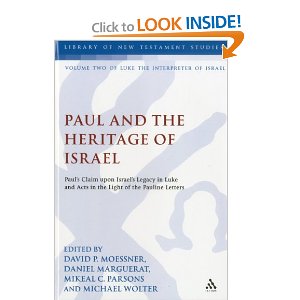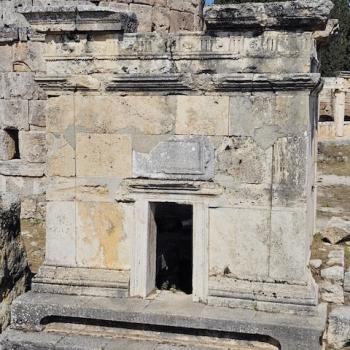While the conclusion of this weighty tome is but six pages long (on which see the coda below) the final essay is not (pp. 290-317). Jean Francois Landolt (yet another colleague of Marguerat at Lausanne) focuses on Paul as an exemplary figure in his letters (see 1 Thess. 1.6; Gal. 4.12; 1 Cor. 4.16; 11.1; Phil. 3.17) and wants to compare that image with Acts, asking whether Acts also presents Paul as a exemplum. All this is fine and dandy, but Landolt also wants to take Romans 7 as autobiographical, which definitely does not work (see my Romans commentary, ad loc).
In Phil.3.4-14 we have the first person, and get the sense that this section is deeply personal (see the ‘we’ before and after that passage). Paul in this passage contrasts his previous Pharasaic evaluation of his now past life, with his current evaluation of that past life. He is not now suggesting it was all wasted and worthless, he is saying that he now reckons it as a loss, even as excrement due to the surpassing worth of knowing Christ. So what we actually have in this passage is a rhetorical synkrisis or comparison. But what aspects of Paul’s behavior is he calling for imitation of? It would appear to be cross-bearing, because his call to imitation is linked to Paul’s own imitation of Christ himself. So the imitation has to involve something that Christ himself also did.
On pp. 298-99, and really for the first time in this whole volume, in the course of Landholt’s treatment of Rom. 7. Landholt acknowledges that this text from about vss. 7ff. could be an example of rhetorical speech in character or impersonation. Here he cites the early study of Edart. What he does not do is properly distinguish the verb tenses here, where first Paul speaks of Adam as an individual and his unique experience, and then he speaks of those who are in Adam, including Jews who are not yet in Christ. Landholt wants to hold out for Paul speaking about himself in this entire passage, it appears, but that is hard to argue for vsss. 7-13 where we have Adam’s unique story. A better case could be made for Paul placing himself along with all other non-Christians in the purvey of vss. 14-25 as one of all who are in Adam. This however also doesn’t work since Paul in Phil. 3 says he was blameless when it came to the Law, not trapped by it and unable to fulfill it. Landholt ends by arguing that Rom. 7.7-25 echoes Gen. 2-3 and deals with our common humanity (including Paul’s), again ignoring the verb tenses and the aspects of vss. 7-13 which could only refer to Adam’s unique experience (‘I was alive before the Law….’). Indeed, Landholt wants to argue that Romans 7 is about all humanity whether they are converted to Christ or not! But this makes a nonsense of the rhetorical contrast between Rom. 7.5-6 and Rom. 8.1ff on the one hand which do speak of Christian experience, and Rom. 7.7-25 which do not do so.
Landholt examines the three conversion narratives about Paul (Acts 9,22,26) and notices in the first one a theme we also find in the Pauline letters, namely Paul’s suffering for Christ. Saul goes from being the persecutor, to being the one persecuted (pp. 302-03). As is well known the accounts in Acts 22,26 are in the first person, and so here we have Luke stepping into the background (unlike in Acts 9 which is a third person account) and Paul stepping forward and offering self-assessment (according to Luke’s portrayal).
It is a pity that Landholt doies not engage with Tannehill’s landmark study of these three conversion accounts, where he shows how they are intended to have a cumulative effect. Yes, it shows how important Paul’s conversion is to Luke, but more than that, it is an event so crucial to the history of early Christianity and so complex in various ways that it requires several unpackings, just like the life of Jesus does in the Gospels (see my treatment of the three accounts in my Acts commentary). Landholt suggests that Luke is stressing the reversal in Paul’s identity in Acts 9, and in Acts 22 the continuity of his new identity with Judaism (p. 305). Marguerat thinks the three accounts are intended to provide a sort of blueprint of conversion of persons.
Landholt spends time analyzing John Lentz’s views on the portrait of Paul in Acts. Certainly, Lentz is right that Luke portrays Paul as a person of considerable social status, even as a Roman citizen. Landholt does not debate whether this portrait is accurate or not, but he does go on the critique various elements in Lentz’s analysis. Landholt is able to show how both Phil. 3 and the Acts conversion accounts say about the same thing in regard to Paul’s relationship to the Law and to Jesus, prior to, and then after the conversion. Both emphasize what a change of perspective Paul has on these things after Damascus Road. As Landholt says, the question becomes in what lies the continuity between Paul and Judaism? His conversion is a radical one, Paul’s message has a considerable degree of novelty to it. Paul did not learn to preach a crucified messiah by diligent study as a Pharisee. The point is, when Paul claims to be a Jew, it is a radical and new kind of messianic Judaism he is talking about.
The language of imitation is then treated a bit more, and it is noted that imitation of Christ involves cross-bearing and suffering, and that Paul becomes an exemplum for his and Luke’s audience not merely of how to bear suffering in general, but more specifically how to bear and overcoming suffering for Christ, and suffering like Christ. Landholt faults Lentz for over-emphasizing Paul’s status as a Roman citizen etc. at the expense of what actually happens in the trial narrative. Paul is an example not because he is a Roman citizen or a social elite, but because like Christ he suffers for the Gospel. And he can also be seen as an example in his radical conversion as well.
CODA
Sometimes editors do their best to stay in the background and resist the temptation to have the last word, or even correct some things the essayists said, and this volume is an example of that. Admirable restraint on their part. They reflect a bit on the demise of the Tubingen model of analyzing an Acts which portrays a Paul at odds with the portrait of the undisputed letters, and stress that two factors most contributed to this in the current era: 1) a more sophisticated approach to narrative, which, among other things recognizes that Luke is a theologian and narrative is the means by which he conveys it. “Rather than dumb down the pure logos of discursive thought, narrative enables great subtleties of thought to be expressed in equally if not even more complex ways of enlightenment” (p. 319). Exactly. Luke uses narrative to stress, confirm, and even refute some things about the early Christian movement, which should not be seen as inferior to the more discursive rhetoric of Paul.
What is odd about the conclusions comes to light in the following comment: “The application of rhetoric to both the discursive arguments of the Pauline letters and to the narrative-rhetorical strategies of the Lukan narrative have yielded dramatic results.” (p. 319). You would never guess this comment was true about Paul’s letters from the essays in this volume, where it hardly comes up at all, and is, in my judgment, a significant lacuna in this volume. More debatable is the discussion in the volume about ‘the reception history of Paul and his letters’ when Paul’s own letters are seen as contributing to this later reception or legacy. Still Hays is right that Luke’s portrait of Paul is an organic development within a Pauline symbolic universe in which OT texts are used in similar ways to make one’s theological points. Paulinism, as it turns out, is not the betrayal of Paul, but rather the later portrayal of the genuine Paul, amplified, and extended to new audiences and days.
There is a strong emphasis at the very close of the book on how both Luke and Paul are continuators, when it comes to the religion and legacy of early Judaism, not supercessionists. While I certainly agree with this, what is also true is that they are both convinced that the early Christian movement is the true continuation, the true development of Judaism into its proper messianic form. It would be hard for such a viewpoint not to be seen by non-Christian Jews as a replacement theology, even though it was not intended to be such. If one argues that “Jesus of Nazareth is Israel’s true heritage and enduring legacy to the world” (p. 321) one is saying that the axis of emphasis has changed, and it will never do to relegate, sublimate, ignore, or deny this legacy. What is clear from both Acts and Paul is that Paul is one of the main instigators of the change in this Jewish symbolic universe. The book concludes “Whoever Luke was, Paul and the Heritage of Israel demonstrates that he is intent on showing how the Christian movement, represented iconically (and ironically!) by Paul, is organically tied to the history and scriptures of Israel and claims its heritage as the legitimate growth and flowering of God’s election of a special people.” Just so, and to use Pauline language, those people are Jew and Gentile united in Christ.













